Input interpretation

NaOH sodium hydroxide + CaCO_3 calcium carbonate ⟶ Ca(OH)_2 calcium hydroxide + Na_2CO_3 soda ash
Balanced equation
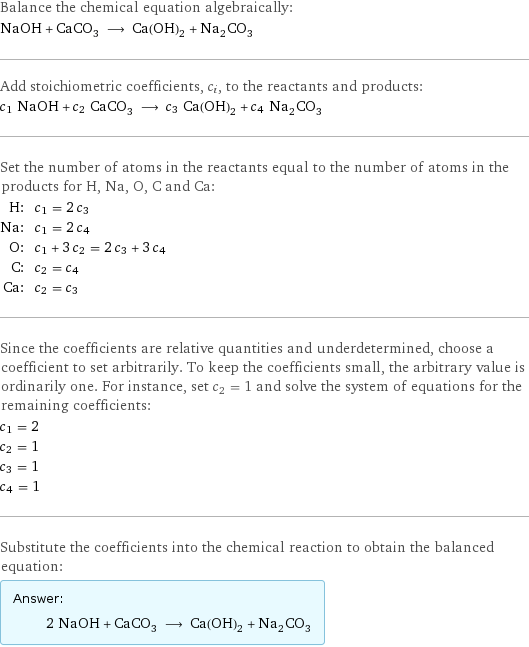
Balance the chemical equation algebraically: NaOH + CaCO_3 ⟶ Ca(OH)_2 + Na_2CO_3 Add stoichiometric coefficients, c_i, to the reactants and products: c_1 NaOH + c_2 CaCO_3 ⟶ c_3 Ca(OH)_2 + c_4 Na_2CO_3 Set the number of atoms in the reactants equal to the number of atoms in the products for H, Na, O, C and Ca: H: | c_1 = 2 c_3 Na: | c_1 = 2 c_4 O: | c_1 + 3 c_2 = 2 c_3 + 3 c_4 C: | c_2 = c_4 Ca: | c_2 = c_3 Since the coefficients are relative quantities and underdetermined, choose a coefficient to set arbitrarily. To keep the coefficients small, the arbitrary value is ordinarily one. For instance, set c_2 = 1 and solve the system of equations for the remaining coefficients: c_1 = 2 c_2 = 1 c_3 = 1 c_4 = 1 Substitute the coefficients into the chemical reaction to obtain the balanced equation: Answer: | | 2 NaOH + CaCO_3 ⟶ Ca(OH)_2 + Na_2CO_3
Structures

+ ⟶ +
Names

sodium hydroxide + calcium carbonate ⟶ calcium hydroxide + soda ash
Reaction thermodynamics
Enthalpy
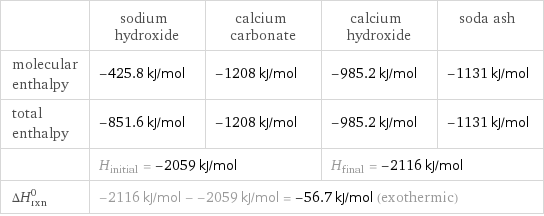
| sodium hydroxide | calcium carbonate | calcium hydroxide | soda ash molecular enthalpy | -425.8 kJ/mol | -1208 kJ/mol | -985.2 kJ/mol | -1131 kJ/mol total enthalpy | -851.6 kJ/mol | -1208 kJ/mol | -985.2 kJ/mol | -1131 kJ/mol | H_initial = -2059 kJ/mol | | H_final = -2116 kJ/mol | ΔH_rxn^0 | -2116 kJ/mol - -2059 kJ/mol = -56.7 kJ/mol (exothermic) | | |
Gibbs free energy
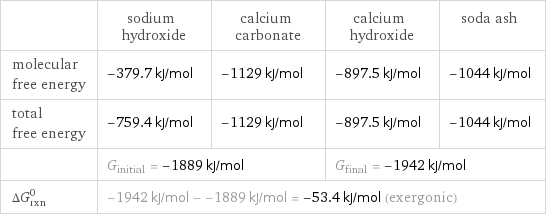
| sodium hydroxide | calcium carbonate | calcium hydroxide | soda ash molecular free energy | -379.7 kJ/mol | -1129 kJ/mol | -897.5 kJ/mol | -1044 kJ/mol total free energy | -759.4 kJ/mol | -1129 kJ/mol | -897.5 kJ/mol | -1044 kJ/mol | G_initial = -1889 kJ/mol | | G_final = -1942 kJ/mol | ΔG_rxn^0 | -1942 kJ/mol - -1889 kJ/mol = -53.4 kJ/mol (exergonic) | | |
Entropy
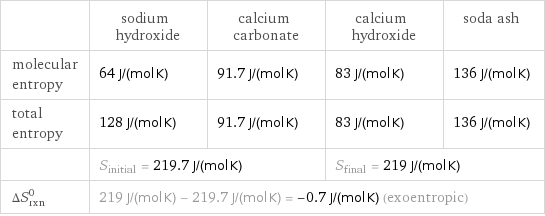
| sodium hydroxide | calcium carbonate | calcium hydroxide | soda ash molecular entropy | 64 J/(mol K) | 91.7 J/(mol K) | 83 J/(mol K) | 136 J/(mol K) total entropy | 128 J/(mol K) | 91.7 J/(mol K) | 83 J/(mol K) | 136 J/(mol K) | S_initial = 219.7 J/(mol K) | | S_final = 219 J/(mol K) | ΔS_rxn^0 | 219 J/(mol K) - 219.7 J/(mol K) = -0.7 J/(mol K) (exoentropic) | | |
Equilibrium constant
![Construct the equilibrium constant, K, expression for: NaOH + CaCO_3 ⟶ Ca(OH)_2 + Na_2CO_3 Plan: • Balance the chemical equation. • Determine the stoichiometric numbers. • Assemble the activity expression for each chemical species. • Use the activity expressions to build the equilibrium constant expression. Write the balanced chemical equation: 2 NaOH + CaCO_3 ⟶ Ca(OH)_2 + Na_2CO_3 Assign stoichiometric numbers, ν_i, using the stoichiometric coefficients, c_i, from the balanced chemical equation in the following manner: ν_i = -c_i for reactants and ν_i = c_i for products: chemical species | c_i | ν_i NaOH | 2 | -2 CaCO_3 | 1 | -1 Ca(OH)_2 | 1 | 1 Na_2CO_3 | 1 | 1 Assemble the activity expressions accounting for the state of matter and ν_i: chemical species | c_i | ν_i | activity expression NaOH | 2 | -2 | ([NaOH])^(-2) CaCO_3 | 1 | -1 | ([CaCO3])^(-1) Ca(OH)_2 | 1 | 1 | [Ca(OH)2] Na_2CO_3 | 1 | 1 | [Na2CO3] The equilibrium constant symbol in the concentration basis is: K_c Mulitply the activity expressions to arrive at the K_c expression: Answer: | | K_c = ([NaOH])^(-2) ([CaCO3])^(-1) [Ca(OH)2] [Na2CO3] = ([Ca(OH)2] [Na2CO3])/(([NaOH])^2 [CaCO3])](../image_source/73afce369da6b9a44a5f4c01b05d63b8.png)
Construct the equilibrium constant, K, expression for: NaOH + CaCO_3 ⟶ Ca(OH)_2 + Na_2CO_3 Plan: • Balance the chemical equation. • Determine the stoichiometric numbers. • Assemble the activity expression for each chemical species. • Use the activity expressions to build the equilibrium constant expression. Write the balanced chemical equation: 2 NaOH + CaCO_3 ⟶ Ca(OH)_2 + Na_2CO_3 Assign stoichiometric numbers, ν_i, using the stoichiometric coefficients, c_i, from the balanced chemical equation in the following manner: ν_i = -c_i for reactants and ν_i = c_i for products: chemical species | c_i | ν_i NaOH | 2 | -2 CaCO_3 | 1 | -1 Ca(OH)_2 | 1 | 1 Na_2CO_3 | 1 | 1 Assemble the activity expressions accounting for the state of matter and ν_i: chemical species | c_i | ν_i | activity expression NaOH | 2 | -2 | ([NaOH])^(-2) CaCO_3 | 1 | -1 | ([CaCO3])^(-1) Ca(OH)_2 | 1 | 1 | [Ca(OH)2] Na_2CO_3 | 1 | 1 | [Na2CO3] The equilibrium constant symbol in the concentration basis is: K_c Mulitply the activity expressions to arrive at the K_c expression: Answer: | | K_c = ([NaOH])^(-2) ([CaCO3])^(-1) [Ca(OH)2] [Na2CO3] = ([Ca(OH)2] [Na2CO3])/(([NaOH])^2 [CaCO3])
Rate of reaction
![Construct the rate of reaction expression for: NaOH + CaCO_3 ⟶ Ca(OH)_2 + Na_2CO_3 Plan: • Balance the chemical equation. • Determine the stoichiometric numbers. • Assemble the rate term for each chemical species. • Write the rate of reaction expression. Write the balanced chemical equation: 2 NaOH + CaCO_3 ⟶ Ca(OH)_2 + Na_2CO_3 Assign stoichiometric numbers, ν_i, using the stoichiometric coefficients, c_i, from the balanced chemical equation in the following manner: ν_i = -c_i for reactants and ν_i = c_i for products: chemical species | c_i | ν_i NaOH | 2 | -2 CaCO_3 | 1 | -1 Ca(OH)_2 | 1 | 1 Na_2CO_3 | 1 | 1 The rate term for each chemical species, B_i, is 1/ν_i(Δ[B_i])/(Δt) where [B_i] is the amount concentration and t is time: chemical species | c_i | ν_i | rate term NaOH | 2 | -2 | -1/2 (Δ[NaOH])/(Δt) CaCO_3 | 1 | -1 | -(Δ[CaCO3])/(Δt) Ca(OH)_2 | 1 | 1 | (Δ[Ca(OH)2])/(Δt) Na_2CO_3 | 1 | 1 | (Δ[Na2CO3])/(Δt) (for infinitesimal rate of change, replace Δ with d) Set the rate terms equal to each other to arrive at the rate expression: Answer: | | rate = -1/2 (Δ[NaOH])/(Δt) = -(Δ[CaCO3])/(Δt) = (Δ[Ca(OH)2])/(Δt) = (Δ[Na2CO3])/(Δt) (assuming constant volume and no accumulation of intermediates or side products)](../image_source/c3a259e2a05d3c77fa91e7b8c4aee903.png)
Construct the rate of reaction expression for: NaOH + CaCO_3 ⟶ Ca(OH)_2 + Na_2CO_3 Plan: • Balance the chemical equation. • Determine the stoichiometric numbers. • Assemble the rate term for each chemical species. • Write the rate of reaction expression. Write the balanced chemical equation: 2 NaOH + CaCO_3 ⟶ Ca(OH)_2 + Na_2CO_3 Assign stoichiometric numbers, ν_i, using the stoichiometric coefficients, c_i, from the balanced chemical equation in the following manner: ν_i = -c_i for reactants and ν_i = c_i for products: chemical species | c_i | ν_i NaOH | 2 | -2 CaCO_3 | 1 | -1 Ca(OH)_2 | 1 | 1 Na_2CO_3 | 1 | 1 The rate term for each chemical species, B_i, is 1/ν_i(Δ[B_i])/(Δt) where [B_i] is the amount concentration and t is time: chemical species | c_i | ν_i | rate term NaOH | 2 | -2 | -1/2 (Δ[NaOH])/(Δt) CaCO_3 | 1 | -1 | -(Δ[CaCO3])/(Δt) Ca(OH)_2 | 1 | 1 | (Δ[Ca(OH)2])/(Δt) Na_2CO_3 | 1 | 1 | (Δ[Na2CO3])/(Δt) (for infinitesimal rate of change, replace Δ with d) Set the rate terms equal to each other to arrive at the rate expression: Answer: | | rate = -1/2 (Δ[NaOH])/(Δt) = -(Δ[CaCO3])/(Δt) = (Δ[Ca(OH)2])/(Δt) = (Δ[Na2CO3])/(Δt) (assuming constant volume and no accumulation of intermediates or side products)
Chemical names and formulas
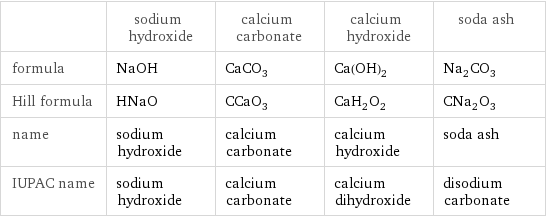
| sodium hydroxide | calcium carbonate | calcium hydroxide | soda ash formula | NaOH | CaCO_3 | Ca(OH)_2 | Na_2CO_3 Hill formula | HNaO | CCaO_3 | CaH_2O_2 | CNa_2O_3 name | sodium hydroxide | calcium carbonate | calcium hydroxide | soda ash IUPAC name | sodium hydroxide | calcium carbonate | calcium dihydroxide | disodium carbonate
Substance properties
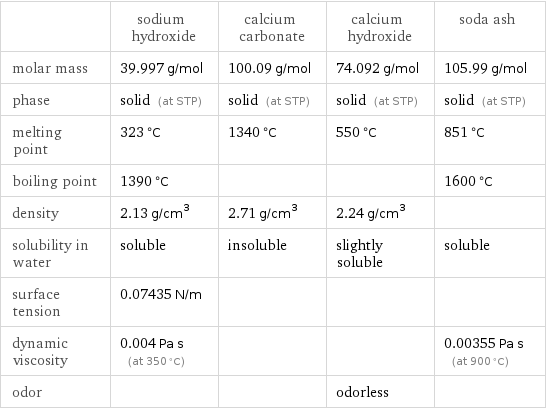
| sodium hydroxide | calcium carbonate | calcium hydroxide | soda ash molar mass | 39.997 g/mol | 100.09 g/mol | 74.092 g/mol | 105.99 g/mol phase | solid (at STP) | solid (at STP) | solid (at STP) | solid (at STP) melting point | 323 °C | 1340 °C | 550 °C | 851 °C boiling point | 1390 °C | | | 1600 °C density | 2.13 g/cm^3 | 2.71 g/cm^3 | 2.24 g/cm^3 | solubility in water | soluble | insoluble | slightly soluble | soluble surface tension | 0.07435 N/m | | | dynamic viscosity | 0.004 Pa s (at 350 °C) | | | 0.00355 Pa s (at 900 °C) odor | | | odorless |
Units
